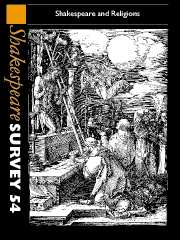Book contents
- Frontmatter
- Shakespeare and the Protestant Mind
- Divine [ ]sences
- ‘An alien people clutching their Gods’?: Shakespeare’s Ancient Religions
- ‘He drew the Liturgy, and framed the rites’: The Changing Role of Religious Disposition in Shakespeare's Reception
- Jonson, Shakespeare, and the Religion of Players
- The Bard and Ireland: Shakespeare’s Protestantism as Politics in Disguise
- ‘Every Good Gift From Above’ Archbishop Trench’s Tercentenary Sermon
- Anthony Munday and The Merchant of Venice
- Perfect Answers: Religious Inquisition, Falstaffian Wit
- When Suicide Becomes an Act of Honour: Julius Caesar and Hamlet in Late Nineteenth-Century Japan
- Religion in Arden
- A Wedding and Four Funerals: Conjunction and Commemoration in Hamlet
- Between Religion and Ideology: Some Russian Hamlets of the Twentieth Century
- Of Shadows and Stones: Revering and Translating ‘the Word’ Shakespeare in Mexico
- Ministers, Magistrates and the Production of ‘Order’ in Measure for Measure
- The Hebrew Who Turned Christian: The First Translator of Shakespeare into the Holy Tongue
- Shakespeare and English Performance Style: The European Context
- All At Sea: Water, Syntax, and Character Dissolution in Shakespeare
- King John, König Johann: War and Peace
- The Tempest’s Forgotten Exile
- The Old Lady, or All is Not True
- Shakespeare Performances in England, 2000
- Professional Shakespeare Productions in the British Isles January-December 1999
- The Year's Contributions to Shakespearian Study 1 Critical Studies
- 2 Shakespeare’s Life, Times, and Stage
- 3 Editions and Textual Studies
- Books Received
- Index
Of Shadows and Stones: Revering and Translating ‘the Word’ Shakespeare in Mexico
Published online by Cambridge University Press: 28 March 2007
- Frontmatter
- Shakespeare and the Protestant Mind
- Divine [ ]sences
- ‘An alien people clutching their Gods’?: Shakespeare’s Ancient Religions
- ‘He drew the Liturgy, and framed the rites’: The Changing Role of Religious Disposition in Shakespeare's Reception
- Jonson, Shakespeare, and the Religion of Players
- The Bard and Ireland: Shakespeare’s Protestantism as Politics in Disguise
- ‘Every Good Gift From Above’ Archbishop Trench’s Tercentenary Sermon
- Anthony Munday and The Merchant of Venice
- Perfect Answers: Religious Inquisition, Falstaffian Wit
- When Suicide Becomes an Act of Honour: Julius Caesar and Hamlet in Late Nineteenth-Century Japan
- Religion in Arden
- A Wedding and Four Funerals: Conjunction and Commemoration in Hamlet
- Between Religion and Ideology: Some Russian Hamlets of the Twentieth Century
- Of Shadows and Stones: Revering and Translating ‘the Word’ Shakespeare in Mexico
- Ministers, Magistrates and the Production of ‘Order’ in Measure for Measure
- The Hebrew Who Turned Christian: The First Translator of Shakespeare into the Holy Tongue
- Shakespeare and English Performance Style: The European Context
- All At Sea: Water, Syntax, and Character Dissolution in Shakespeare
- King John, König Johann: War and Peace
- The Tempest’s Forgotten Exile
- The Old Lady, or All is Not True
- Shakespeare Performances in England, 2000
- Professional Shakespeare Productions in the British Isles January-December 1999
- The Year's Contributions to Shakespearian Study 1 Critical Studies
- 2 Shakespeare’s Life, Times, and Stage
- 3 Editions and Textual Studies
- Books Received
- Index
Summary
Para Sarah, alma mía
Jan Kott recalls in Aloes that, during one of his many encounters with Peter Brook, the British director was very excitedly discussing what the shadow (or ghost) of Hamlet’s father should do to an audience. After insisting ‘this ghost must make you shiver with fear, it must’, Brook showed Kott a pair of stone figurines – small reproductions of ‘demons from Sumatra’ – and asked: ‘Don’t they make you afraid?’ They didn’t, says Kott; actually, they looked a bit ridiculous. But then,
Peter turned out the lights and placed the larger figure against a window so that it cast a long shadow in the middle of the room. Then he aimed a lamp from another direction. The figure, the shadow, grew in stature; its head was horrible; the shadow was terrifying and disgusting. I shivered. I started to feel afraid.
Despite its evident emphasis on religion and mind (on providence, doubt, scepticism, procrastination, and the like), to me, Hamlet is Shakespeare's most provocative engagement with shadows - the darkest shadows. For the shades, dreams, images and ghosts that appear in other plays seem less dense, less obscure and threatening when compared to the shadows that populate Elsinore. Every character in Hamlet becomes a shadow, or the shadow of another. Following Shakespeare's own example, it is possible to say that the characters of Hamlet are translated into shadows: Hamlet senior stalks Hamlet junior as much as Polonius shadows him and orders Ophelia to play a similar game, while Hamlet drops in on Claudius, who has Polonius, Rosencrantz and Guildenstern play the clownish detectives shadowing Hamlet's every move, and so on.
- Type
- Chapter
- Information
- Shakespeare Survey , pp. 152 - 164Publisher: Cambridge University PressPrint publication year: 2001
- 2
- Cited by



